How to Train Clients With Asthma (Step-by-Step Guide)
Diversifying your clientele by knowing how to train clients with asthma can significantly expand your personal training business. However, it’s crucial that you have the right methods to train asthmatic clients safely and efficiently. Leveraging various features of personal training software can help you achieve this goal. Discover how to effectively train clients with asthma and understand the tools you’ll need in this thorough guide.
- Asthma requires special care during workouts; your clients’ activities should not trigger their symptoms. Therefore, an initial, thorough assessment is critical.
- Most clients with asthma need to avoid high-intensity, continuous exercises, instead adopting a program with controlled, moderate-intensity workouts.
- The use of workout and assessment software can help ensure the safety of your clients while aiding them in attaining their fitness goals with fewer interruptions.
Diving into the training of special populations, such as clients with asthma, can offer personal trainers a rewarding way to diversify their revenue streams.

To train clients with asthma, you need a deep understanding of the condition and the necessary tools to deliver effective training. This is where personal training software steps in. By using the features of top-quality online personal training software, you can guide clients with asthma in a way that works with their unique needs, not against them.
To experience the leading personal training software from Exercise.com, schedule a demo now!
Understanding Asthma and its Impact on Exercise
Living with asthma can present unique challenges, especially when it comes to exercise and physical fitness. Individuals with asthma often experience a range of symptoms, such as shortness of breath, wheezing, and chest tightness, which can make it difficult to engage in physical activities. However, with proper training and guidance, individuals with asthma can still achieve their fitness goals and enjoy the numerous benefits of exercise.
Asthma is a chronic respiratory condition characterized by inflammation and narrowing of the airways, resulting in difficulty breathing. When individuals with asthma participate in physical activities, they may experience what is known as exercise-induced bronchoconstriction (EIB), where their airways become more inflamed and narrowed. This can lead to symptoms such as coughing, wheezing, and breathlessness during or after exercise. Understanding the impact of asthma on exercise is crucial for creating tailored training programs for clients with asthma.
Exercise-induced bronchoconstriction (EIB) is a common occurrence among individuals with asthma, affecting up to 90% of people with the condition. The severity of EIB can vary from person to person, with some experiencing mild symptoms while others may have more severe reactions. It is important for individuals with asthma to be aware of their triggers and take appropriate measures to manage their symptoms during exercise. This may include using a bronchodilator inhaler before physical activity or adjusting the intensity and duration of their workouts. By understanding the impact of asthma on exercise, healthcare professionals and trainers can work together to develop personalized exercise plans that accommodate the needs and limitations of individuals with asthma.
The Importance of Proper Training for Clients with Asthma
Proper training is essential for clients with asthma to safely engage in exercise and maximize their fitness potential. Working with a knowledgeable fitness professional, such as a certified personal trainer or exercise physiologist, is crucial in designing exercise programs that accommodate the unique needs and limitations associated with asthma. These professionals can provide the necessary expertise and guidance to ensure that clients with asthma can exercise safely and effectively.
One important aspect of proper training for clients with asthma is understanding the triggers that can exacerbate their symptoms. Triggers can vary from person to person, but common ones include cold air, pollen, and certain types of exercise. By identifying and avoiding these triggers, clients with asthma can reduce the likelihood of experiencing an asthma attack during exercise.
In addition to avoiding triggers, clients with asthma can benefit from incorporating specific breathing techniques into their exercise routine. Deep breathing exercises, such as diaphragmatic breathing, can help improve lung function and reduce the likelihood of asthma symptoms during physical activity. Fitness professionals can teach clients these techniques and ensure they are implemented correctly during exercise sessions.
Identifying and Assessing Asthma Triggers in Clients
One of the first steps in training clients with asthma is identifying and assessing their specific triggers. Asthma triggers can vary between individuals and may include allergens, cold air, pollutants, or even specific exercises. Through a comprehensive assessment process, trainers can help clients identify their triggers and develop strategies to minimize exposure and manage symptoms during exercise.
It is important for trainers to educate themselves on common asthma triggers and their potential impact on clients. Allergens such as pollen, dust mites, and pet dander are common triggers that can cause inflammation in the airways. Cold air can also be a trigger, as it can cause the airways to constrict and make breathing more difficult. Pollutants such as smoke, strong odors, and air pollution can also worsen asthma symptoms. Additionally, certain exercises like running or high-intensity workouts can trigger asthma symptoms in some individuals.
Tailoring Exercise Programs for Clients with Asthma
When designing exercise programs for clients with asthma, it is important to consider their fitness goals, current fitness level, and asthma severity. It is crucial to start with a gradual progression, allowing the body to adapt and adjust gradually to the demands of exercise. Programs should incorporate a mix of cardiovascular exercises, strength training, flexibility, and breathing techniques to improve overall fitness while minimizing the risk of exacerbating asthma symptoms.
In addition to these considerations, it is also important to educate clients with asthma about proper warm-up and cool-down techniques. A thorough warm-up helps to prepare the body for exercise and can help reduce the likelihood of asthma symptoms during physical activity. This can include light aerobic exercises, dynamic stretching, and deep breathing exercises. Similarly, a proper cool-down allows the body to gradually return to its resting state and can help prevent post-exercise asthma symptoms. It is recommended to include gentle stretching and relaxation exercises during the cool-down phase.
Breathing Techniques for Managing Asthma during Workouts
Teaching clients proper breathing techniques is vital for managing asthma symptoms during workouts. Deep breathing exercises, such as diaphragmatic breathing, can help clients improve lung function, reduce breathlessness, and promote relaxation. By focusing on breathing techniques and encouraging clients to listen to their bodies, trainers can help them gain better control over their asthma symptoms during workouts.
One effective breathing technique for managing asthma during workouts is pursed lip breathing. This technique involves inhaling through the nose and exhaling slowly through pursed lips, as if blowing out a candle. Pursed lip breathing helps to regulate breathing patterns, prevent rapid breathing, and reduce the feeling of breathlessness during exercise.
In addition to breathing techniques, it is important for individuals with asthma to warm up properly before engaging in intense physical activity. A warm-up routine that includes light aerobic exercises and stretching can help prepare the body for exercise and minimize the risk of asthma symptoms. Trainers should also encourage clients to have their rescue inhaler readily available during workouts, in case they experience an asthma attack.
Warm-up and Cool-down Strategies for Clients with Asthma
Proper warm-up and cool-down routines are essential for clients with asthma to prepare their bodies for exercise and facilitate recovery. A well-designed warm-up should include dynamic stretches and low-intensity cardio exercises to gradually increase heart rate and open up the airways. Similarly, a cool-down should incorporate gentle stretches and deep breathing exercises to promote relaxation and aid in reducing post-exercise asthma symptoms.
In addition to dynamic stretches and low-intensity cardio exercises, clients with asthma can benefit from incorporating specific breathing techniques into their warm-up routine. Diaphragmatic breathing, also known as belly breathing, can help improve lung function and increase oxygen intake. This involves taking slow, deep breaths, focusing on expanding the belly rather than the chest. Another effective breathing technique is pursed-lip breathing, which involves inhaling through the nose and exhaling slowly through pursed lips. These breathing exercises can help clients with asthma better control their breathing during exercise and reduce the risk of asthma symptoms.
Furthermore, it is important for clients with asthma to be aware of environmental factors that may trigger their symptoms during warm-up and cool-down activities. Outdoor exercise in cold weather or high pollen count areas can exacerbate asthma symptoms. In such cases, it is advisable to warm up and cool down indoors or in a controlled environment. Additionally, clients should consider wearing a scarf or mask to cover their mouth and nose during outdoor activities to help filter the air they breathe and reduce exposure to potential triggers.
Choosing the Right Intensity and Duration of Exercise for Asthmatic Clients
Selecting the appropriate intensity and duration of exercise is crucial for clients with asthma to prevent overexertion and minimize the risk of triggering symptoms. Moderate-intensity exercises, such as brisk walking or swimming, are often well-tolerated by individuals with asthma. It is important to monitor clients closely during workouts and modify the intensity and duration as needed based on their symptoms and overall comfort.
Monitoring Symptoms and Adjusting Training Accordingly
Continual monitoring of asthma symptoms is essential throughout the training process. Clients with asthma should be encouraged to keep a log of their symptoms, exercise duration, and intensity to identify any patterns or triggers. Based on the symptoms and their progression, trainers can make necessary adjustments to the training program to ensure safety and optimal results.
Building Endurance Safely for Clients with Asthma
Endurance training plays a vital role in improving cardiovascular fitness and promoting overall health. However, for clients with asthma, it is crucial to approach endurance training with caution. Gradual progression, incorporating interval training, and allowing for adequate recovery time are key strategies to build endurance safely for clients with asthma.
Strength Training Guidelines for Individuals with Asthma
Strength training offers numerous benefits for individuals with asthma, such as improved muscle strength, posture, and bone density. When designing strength training programs, it is important to focus on proper form and technique to minimize the risk of triggering asthma symptoms. Trainers should also consider incorporating exercises that target the muscles involved in the breathing process to enhance respiratory muscle strength.
Incorporating Interval Training for Improved Respiratory Fitness in Asthmatic Clients
Interval training, which involves alternating between high-intensity bursts of exercise and periods of rest, can be highly effective in improving respiratory fitness in individuals with asthma. This type of training allows clients to challenge their respiratory system while still providing adequate recovery time. Trainers should design interval training programs that gradually increase in intensity to promote adaptation and prevent asthma symptoms.
Tips for Managing Exercise-Induced Asthma Symptoms during Workouts
Exercise-induced asthma symptoms can be distressing for clients during workouts. However, with proper strategies, these symptoms can be effectively managed. Encouraging clients to warm up sufficiently, use prescribed medications as directed, monitor their breathing, and focus on controlled breathing techniques can help minimize the impact of exercise-induced asthma symptoms and allow for a more enjoyable workout experience.
Educating Clients on Medication Management and Inhaler Use
Proper medication management is crucial for individuals with asthma to effectively control their symptoms and participate in physical activities. Fitness professionals should educate their clients about the importance of taking prescribed medications as directed and ensure they understand how to use their inhalers correctly. Collaborating with healthcare professionals, such as the client’s primary care physician or pulmonologist, is essential in providing comprehensive care and support.
Enhancing Lung Function through Cardiovascular Training Methods
Cardiovascular training is a cornerstone of any fitness program, and for individuals with asthma, it can also help improve lung function. By regularly engaging in aerobic exercises, clients can enhance their lung capacity, increase their tolerance to physical exertion, and reduce the severity of asthma symptoms over time. Trainers should incorporate a variety of cardiovascular exercises, such as cycling, swimming, or jogging, to provide a well-rounded training experience.
Creating a Supportive Environment and Encouraging Self-Care among Asthmatic Clients
Creating a supportive and inclusive exercise environment is vital for clients with asthma to feel comfortable and motivated. Understanding the challenges they may face and providing necessary accommodations or modifications can foster a positive training experience. Additionally, promoting self-care practices, such as adequate rest and stress management, can help clients better manage their asthma and maintain their overall well-being.
Addressing Common Concerns and Misconceptions about Exercising with Asthma
There are often misconceptions and concerns regarding exercising with asthma that need to be addressed. Many individuals fear that exercise will worsen their symptoms or that asthma is a barrier to achieving their fitness goals. Trainers should take the time to educate clients about the benefits of exercise for asthma management and help them understand that with proper training and guidance, they can safely and successfully engage in physical activities.
Preparing Clients with Asthma for Outdoor Activities and Sports
Outdoor activities and sports offer unique challenges for clients with asthma, such as exposure to allergens or cold air. Trainers should work closely with clients to develop strategies to minimize triggers, such as wearing appropriate clothing or using preventive medications before outdoor activities. By providing guidance and support, clients can confidently participate in their desired outdoor activities while effectively managing their asthma symptoms.
Collaborating with Healthcare Professionals to Optimize Training Programs
Collaboration with healthcare professionals is essential in optimizing training programs for clients with asthma. Fitness professionals should establish open lines of communication with the client’s healthcare team to ensure a comprehensive approach to care. This collaboration allows for a better understanding of the client’s specific needs, medication adjustments if necessary, and the ability to tailor the training program accordingly.
Success Stories: Real-life Examples of Fitness Achievements by Individuals with Asthma
Sharing success stories of individuals with asthma who have achieved their fitness goals can be a powerful motivator for clients. By highlighting these stories, trainers can inspire clients with asthma to believe in their potential and realize that asthma does not have to be a limitation. These success stories serve as a reminder that with determination, proper training, and ongoing support, individuals with asthma can achieve remarkable fitness achievements.
What is the best method of exercise for people with asthma?
The best method of exercise for people with asthma is typically low-intensity, long-duration activities. These could include walking, cycling, or swimming, which are less likely to trigger asthma symptoms compared to high-intensity workouts.
How do you train with asthma?
When training with asthma, it’s important to start slow, warm up properly before each session, and gradually increase the intensity and duration of workouts. It’s also crucial to manage asthma symptoms effectively. This might involve using prescribed medication before exercise, avoiding triggers like cold air, and ensuring the availability of quick-relief medication during workouts.
What are three considerations for participating in physical activity if your client has asthma?
When a client with asthma participates in physical activity, consider the following:
- Their asthma should be well-controlled and they should have a personalized asthma action plan from their healthcare provider.
- They should always have their quick-relief inhaler nearby in case of an asthma attack.
- Activities should be modified to fit their level of fitness and asthma control, and should take into account environmental factors like air temperature and quality.
What exercises should be avoided with asthma?
It’s not that certain exercises should be completely avoided with asthma, but rather that some might trigger asthma symptoms more easily. High-intensity activities or sports that involve short bursts of exertion like football, basketball, or sprinting can be more challenging for people with asthma. Cold-weather sports like skiing or ice hockey might also trigger symptoms due to the cold, dry air.
What is an exercise challenge for asthma?
An exercise challenge for asthma is a test used to diagnose exercise-induced bronchoconstriction (EIB), a condition where physical exertion triggers asthma symptoms. During this test, the individual exercises under medical supervision, and their lung function is measured before and after to see if exercise triggers asthma symptoms.
Should asthma patients exercise?
Yes, people with asthma should still exercise. Regular physical activity improves overall health and lung function. However, it’s important for individuals with asthma to manage their condition effectively, avoid known triggers, and have a plan for dealing with asthma symptoms during exercise.
Can you take albuterol before exercise?
Yes, a healthcare provider may recommend using a short-acting bronchodilator like albuterol before exercise to prevent exercise-induced bronchoconstriction. However, this should only be done under the guidance of a healthcare provider.
Is cardiovascular exercise good for asthma?
Yes, cardiovascular exercise can be beneficial for individuals with asthma. It helps strengthen the heart and lungs, improves overall fitness, and can also boost the immune system. However, it’s important for people with asthma to start slow and gradually increase the intensity and duration of their workouts.
Should people with asthma do breathing exercises?
Yes, certain breathing exercises can help manage asthma symptoms. Techniques such as diaphragmatic breathing and nasal breathing can help improve lung function and reduce the frequency and severity of asthma attacks.
What is the best exercise to lose weight with asthma?
Low to moderate-intensity exercises such as brisk walking, swimming, cycling, and yoga can be effective for weight loss and are generally well-tolerated by people with asthma. The best exercise will depend on the individual’s personal preferences, fitness level, and asthma control.
Is treadmill good for asthma?
Yes, using a treadmill can be a good choice for people with asthma. It allows for control over the intensity and duration of the workout, and can be done in a controlled indoor environment where it’s easier to avoid asthma triggers.
Use the Best Personal Training Software to Offer a Stellar Client Experience
Training clients with asthma requires a comprehensive and tailored approach. By understanding the impact of asthma on exercise, identifying triggers, incorporating proper techniques, and collaborating with healthcare professionals, fitness professionals can help their clients manage their asthma symptoms safely and effectively. With the right support and guidance, individuals with asthma can overcome barriers and achieve their fitness goals, improving both their physical health and overall quality of life.

To learn more about how Exercise.com can help you run your fitness business, book a demo today!
Creating Training Plans for Clients with Asthma
Here’s how you can help your clients accomplish their training goals by using workout plan creator software to create workout plans, run fitness challenges, offer online workout groups, message clients, and more, all from your very own custom branded fitness apps.
Exercise.com stands out as an all-in-one fitness business management software with comprehensive workout plan sales capabilities. The robust member management, billing & invoicing, and unique fitness assessment tools offer a one-stop solution for fitness business needs. Here’s just some of what you can do with the Exercise.com platform:
Engage with clients via automations.
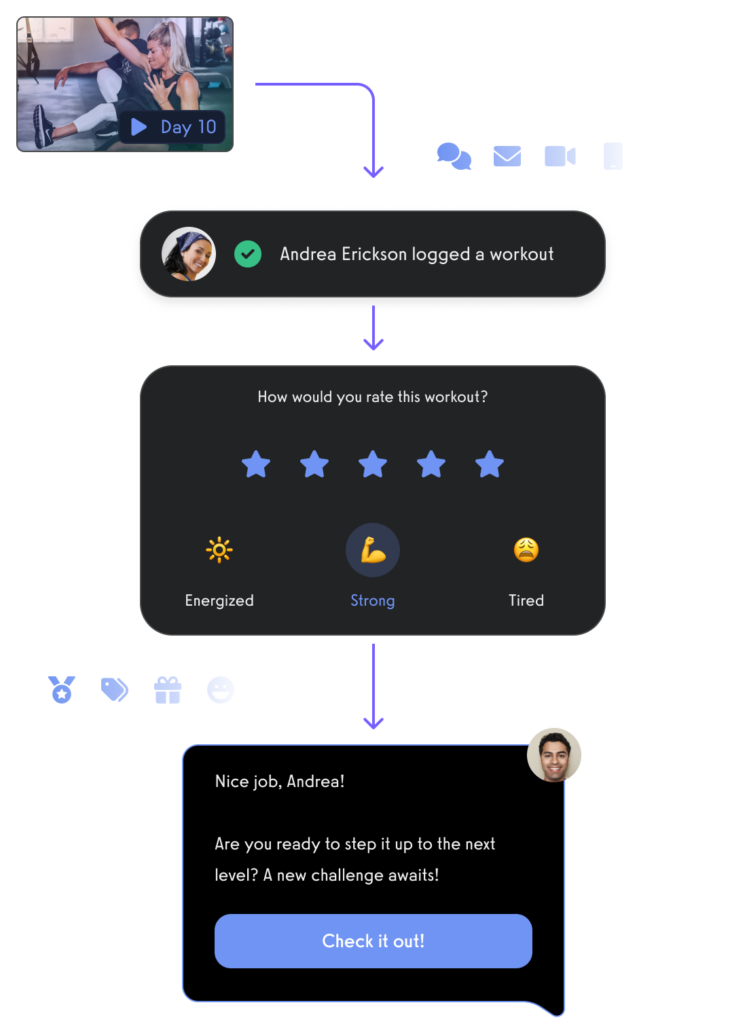
Manage leads with a fitness CRM.

Create and send fitness assessments with ease.
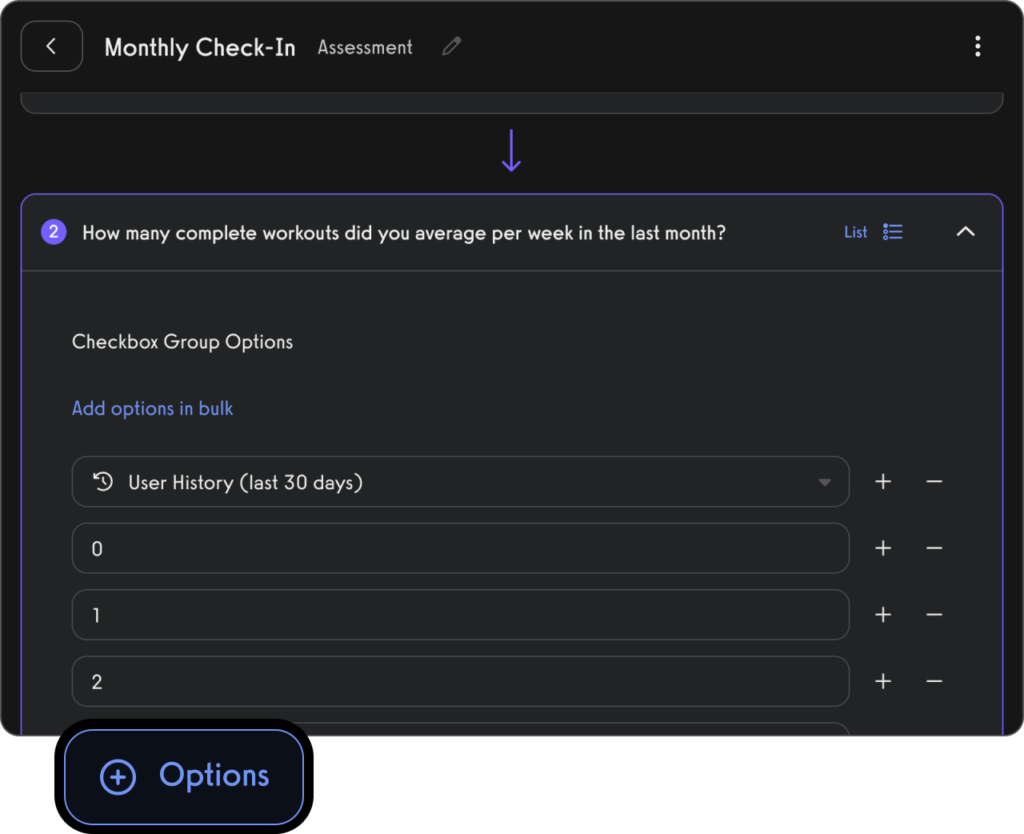
Use fitness habit tracking to inspire and motivate personal training clients (in-person and remote).

Use fitness progress photos to engage with clients.
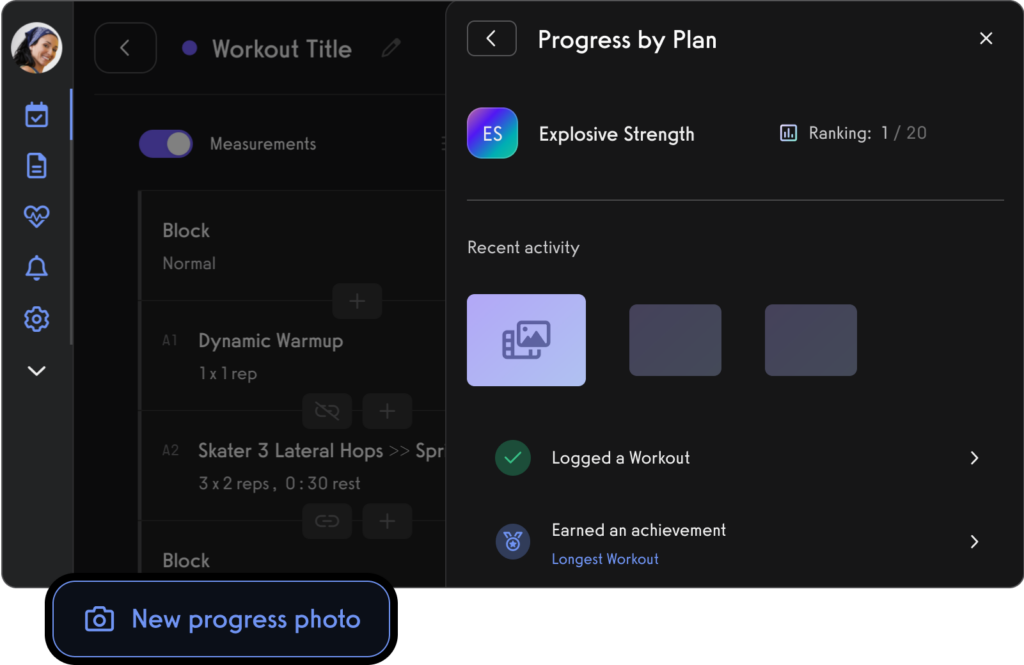
Use fitness leaderboards to track performance and inspire healthy competition.

Use the exercise demonstration video library or create your own custom exercise demonstration videos.

Create workout plans for parents and dependents, teams and more.

Manage personal training clients with ease.

Book appointments for clients (Read More: Best Gym Booking Software)

Create classes and fitness groups

Manage fitness challenges (Read More: 100+ Fitness Challenge Ideas)
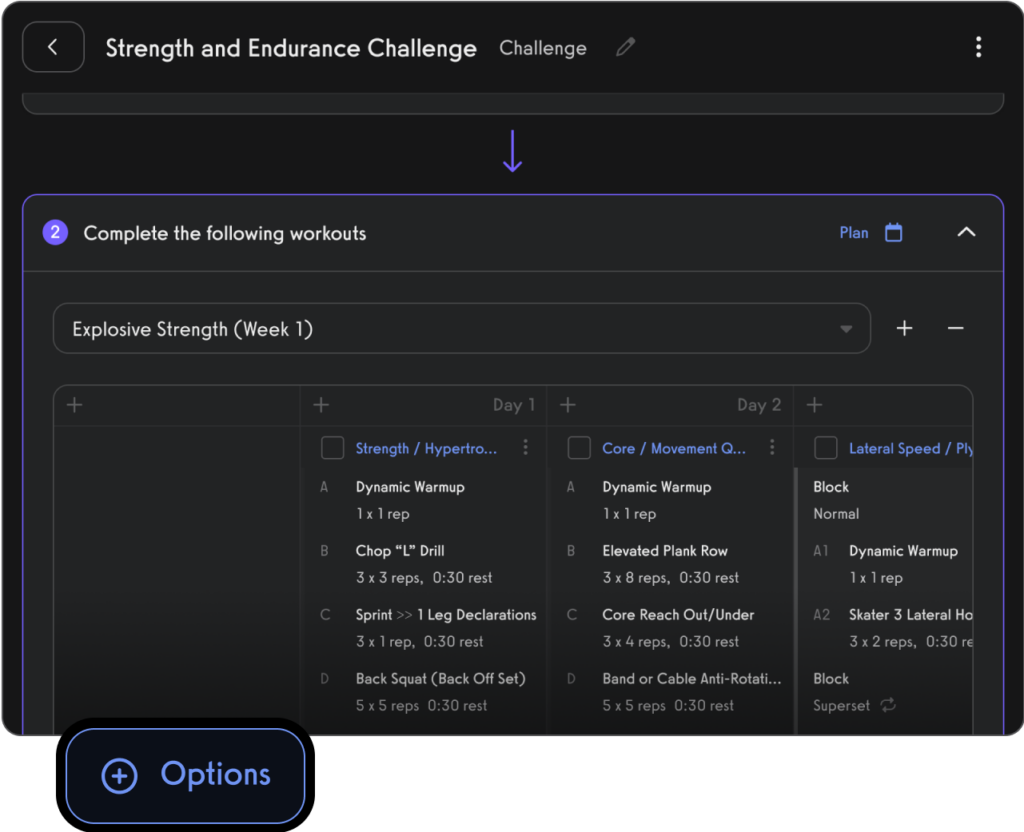
Process payments for open gym, classes, and personal training.

Communicate with gym members, athletes, team members, personal training clients, class members, parents, and dependents via SMS, email, and in-app push notification.

View performance over time, track personal records, and other fitness stats with performance reporting dashboards.
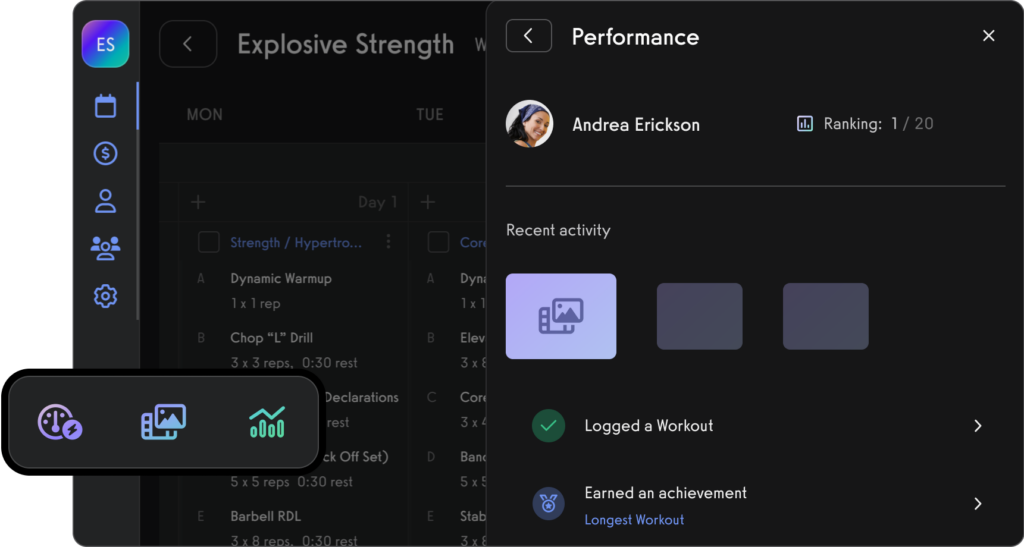
And of course, view all of your fitness business reports easily too.

All from your custom-branded fitness apps (Read More: Best Gym Mobile Fitness Apps Software)

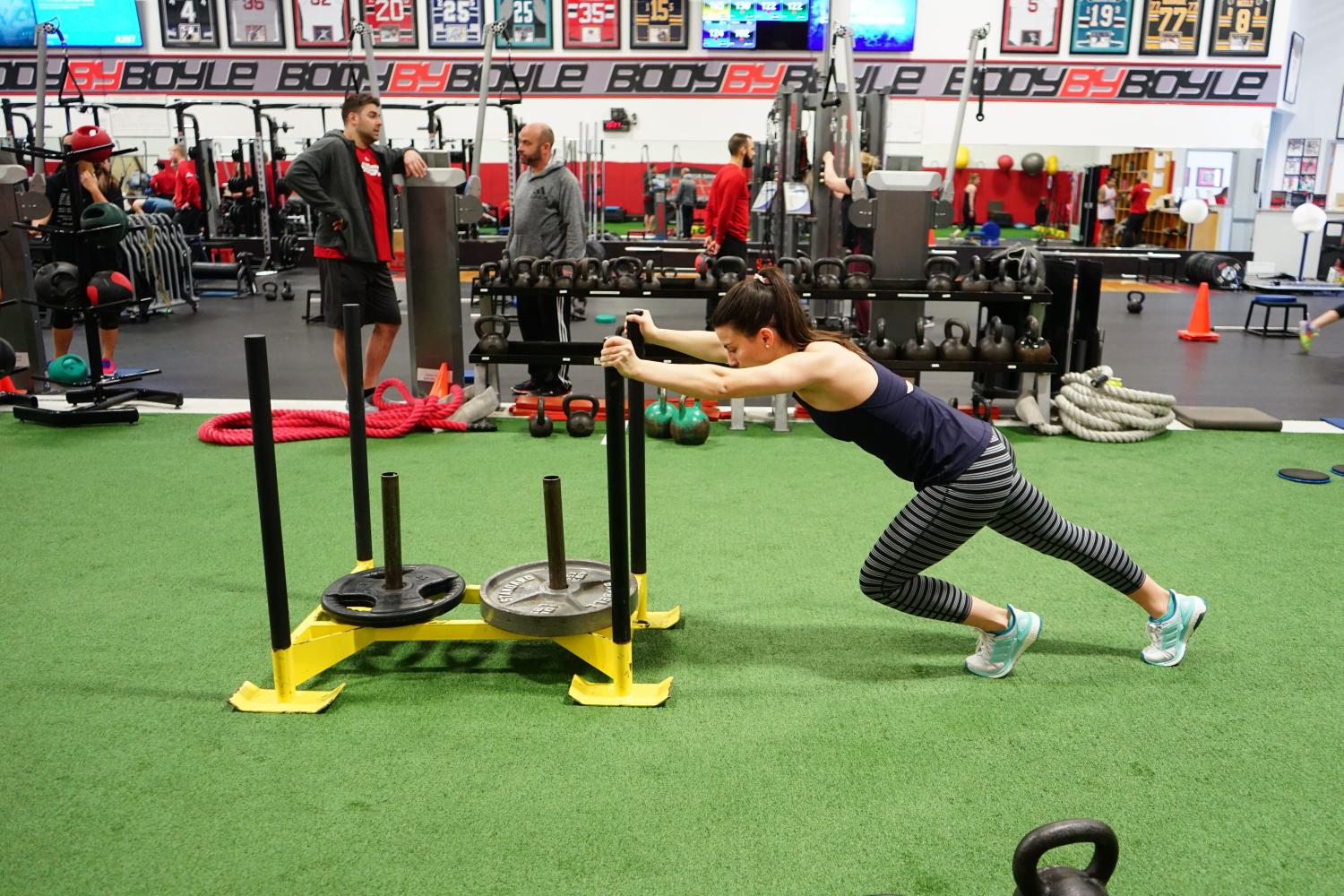
Want to learn how your fitness business can take it to the next level? Get a demo now!









